Wendy Whelan retires from the New York City Ballet after thirty fertile years.
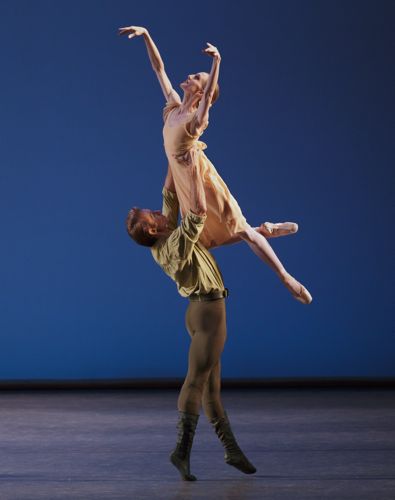
Wendy Whelan and Adrian Danchig-Waring in Jerome Robbins’s Dances at a Gathering. Photo: Paul Kolnick.
In 2008, Nikolaj Hübbe was leaving his position as a principal dancer with the New York City Ballet to become the artistic director of the Royal Danish Ballet, where he had gotten his start. At a cocktail reception in his honor thrown at the Danish Consulate, someone asked him which ballerina he would miss dancing with most. He didn’t even have to think it over. “Wendy,” he said, “Wendy, of course.”
Anyone watching Wendy Whelan dance in all of the five ballets that she had chosen for her official Farewell Performance with the New York City Ballet, could understand Hübbe’s feelings well. It’s not just that she must weigh very little (muscles, sinews, and bones with a minimum of flesh covering them); it is in part her responsiveness to whatever partner she is dancing with. No matter how ostentatious a lift—say one of those soviet-style Waiter with Woman on Platter affairs—she somehow looks as if the move was her idea, and she’s happy (or disconsolate) to explore what it feels like to be held high and/or carried around. In many cases, you can believe that she has redefined the process for herself—not “I am being manipulated,” but “I am being assisted,” possibly with an added phrase: “by this really lovely man.”
She is also wonderfully musical, physically gifted, and extremely versatile. As she herself has cheerfully admitted, she doesn’t look like a diehard’s idea of a ballerina. No tiny waist or swan-like neck, although her legs and feet are long, strong, and shapely and her arms sinuous. What I love about watching her onstage is that she can be elegant or awkward, vulnerable or steely, brazen or modest, worldly wise or innocent. In some subtle way, she reminds me of a ballerina from an earlier generation in the NYCB: Tanaquil Le Clercq. However, she doesn’t have that French spiciness; she’s an American with a smile as wide as it can get.
Whelan chose the program for her official farewell performance wisely, representing four choreographers whose ballets helped shape her artistry—two of whom in doing so may have expanded their visions. George Balanchine had recently died when she became an apprentice in the company; her only contact with him in person was passing him in halls when she was a student in the School of American Ballet, yet she danced in countless of his ballets—as angular as Agon, as classical in form and romantic in feeling as Symphony in C. The roles she inherited in Jerome Robbins’s ballets revealed her as wonderfully insectlike in The Cage, and blithe and playful in his Dances at a Gathering; she was in the cast of Brandenburg, the last ballet he made, the year before he died. Wheeldon, however, built seven ballets that featured her, and Alexei Ratmansky cast her in four that he created for NYCB.
To keep the evening moving along and give Whelan time to breathe, the two pauses are taken up with clips from a forthcoming (in 2015) documentary about her and her 30-year career in NYCB, first showing her as a giddy dancing toddler and then as a remarkably well-trained and confident 12-year-old. She pulls out snapshots, joking about her own ugly duckling stage. We see her teaching a class of young women in tutus, rehearsing, and gathering with friends for an informal dinner, at which one of her current dance partners, Craig Hall, toasts her and all applaud warmly. Tyler Angle, another favorite partner, tells what he loves about working with her.
Sitting at her desk before an array of papers, Whelan speaks with matter-of-fact eloquence about the ways in which dancers learn from one another. Jock Soto partnered Heather Watts in a role Whelan later took over; what Soto learned from Watts, he could pass on to Whelan, and she, in turn, could advise later partners because of what Soto told her. And so it will go down the generations. She has a history. Few ballerinas dare wait until they’re 47 to retire.
Her wit and that wide smile are evident in the film too. Spotting Hall in a corridor outside a studio, she feigns jealousy and asks if he has dared to rehearse with another woman (one is standing by); then she gives him a big mock swat with her bag, bursts into a hearty laugh, and moves on.
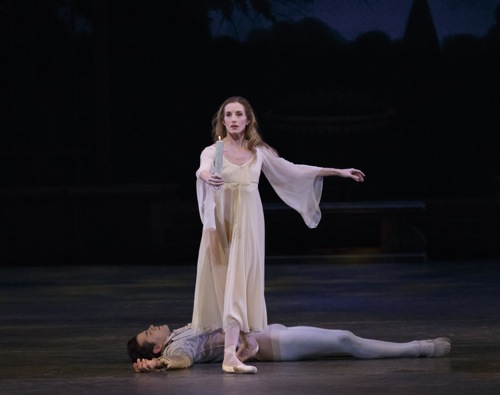
Wendy Whelan not noticing Robert Fairchild in George Balanchine’s La Sonnambula. Photo: Paul Kolnick
The evening’s opener was that fascinating and extremely mysterious (not to say weird) Balanchine ballet, his 1946 La Sonnambula, made when he was affiliated with the Ballet Russe de Monte Carlo. The ballet, set to seething music by Vittorio Rieti seemed a bit thrown together. Although the strangely chipper entertainers (a pretty quartet, a semi-Arabic pas de deux, a high-jumping Harlequin) performed expertly, much of the decadence of this society at a masked ball didn’t really come across. Whelan, however—pallid and with a fixed stare, bourréeing forward and backward with tremulous feet, a motionless body, and a rigid hand holding a candle—made the Sleepwalker into a fragile-appearing creature, both doomed and merciless. Robert Fairchild, as the Poet who dropped by the party, was adroit at the wondering ways in which the enraptured man tests this lovely woman’s vision. Is she a maiden in thrall, the madwoman in the attic, a vampire? Best not to ask.
In an excerpt from Robbins’s gorgeous Dances at a Gathering, Whelan chose to place herself within a community—happy not only to be with her partner, Adrian Danchig-Waring, but with all the others: Abi Stafford, Rebecca Krohn, Tyler Angle, and Zachary Catanzaro. As the woman identified as In Apricot, she’s the one who gets tossed from man to man, as part of a good-humored game, while Cameron Grant makes Chopin’s piano music sing.
The excerpt from Ratmansky’s Concerto DSCH pairs Whelan with Angle, a wonderfully attentive partner, and surrounds them with an ensemble of six (including the company’s new resident choreographer, soloist Justin Peck). In this marvelous ballet, set to Dmitri Shostakovitch’s Piano Concerto No. 2 in F major, Op. 102 (conducted by Andrews Sills and eloquently played by Susan Walters) Whelan is again a member of a small, vividly depicted community, but a rather special one; for all we know it could be her wedding day. The moment when she’s surrounded and lifted high in an upright position with her arms widespread, she looks as if she’s gazing into a beautiful land that the others can’t yet see.
She’s alone with Hall for the excerpt from Wheeldon’s 2005 After the Rain. Grant, at the piano, is joined by violinist Arturo Delmoni to play Arvo Pärt’s mystical Spiegel im Spiegel. The two dancers begin this duet side by side, staring toward the audience, their feet planted wide apart and not turned out in the approved classical style. But although Wheeldon creates some deliberately awkward moments (such as the one in which Hall picks Whelan up while she’s frozen in a backbend and moves her to a slightly different place, as if she’s a new piece of furniture), Whelan seems at times not of this earth. With her hair down, her legs and feet bare, and wearing a barely-there leotard that blends in with her skin, she seems less to be hoisted by her ardent partner than to grow out of him or to cleave to him like ivy to a tree.
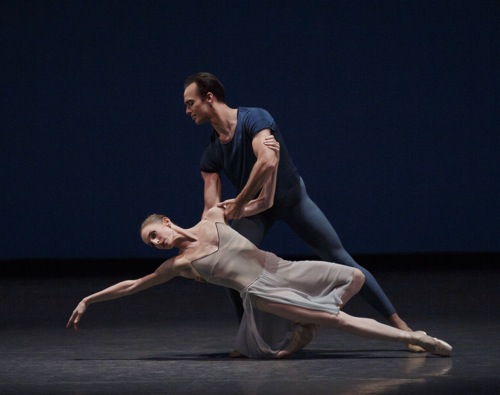
Whelan and Tyler Angle in By Two With & From, by Christopher Wheeldon and Alexei Ratmansky. Photo: Paul Kolnik
Wheeldon and Ratmansky have joined together to choreograph By 2 With & From, a sweet pièce d’occasion in honor of this ballerina they prize. The music is Max Richter’s “recomposition” of Antonio Vivaldi’s The Seasons (Daniel Capps conducts; Kurt Nikkanen plays the violin). Wheeldon has titled his Part I “Spring and Summer,” leaving “Autumn and Winter” to Ratmansky. But really, the two halves of this trio for Whelan, Hall, and Angle fit seamlessly together. Whelan and Angle lie side by side in a pool of light to begin, but the pas de trois is less about rivalrous lovers than about loving comrades—men who share their admiration for this remarkable woman. Dancing with Angle, Whelan gives him a little passing kiss. When Hall enters, the men trade off partnering Whelan. Angle backs out, but soon returns jumping. The two guys dance together in quick-footed unison. Wanting a bit of space for herself under a suddenly deep blue sky (lighting by Penny Jacobus), Whelan steers both of them toward the wings and, with a push, somersaults them off. They return, of course; Hall needs his moment alone with her. The last image is of her standing on Angle’s thighs, like a ship’s figurehead breasting the gale.
The applause was hearty and prolonged. Whelan took bow after bow—first with Hall and Angle, then alone. The bouquets began to accumulate in a heap as various admirers entered one by one, including Wheeldon and NYCB’s Ballet Master Peter Martins entered. Former partners arrived in a cluster, each bestowing on her one long-stemmed rose in a perhaps unintentional, latter-day gloss on Sleeping Beauty’s “Rose Adagio.” Then honored elders like Jacques d’Amboise and other company members, each with a flower. Whelan hugged every single one of them—standing on pointe to embrace tall Teresa Reichlen in high-heeled boots, being lifted off her feet by several ardent men. Her husband, artist David Michalek, got a long kiss. In between entrances, while the applause rolled on, she endearingly tidied up the mounting pile of roses.
Other dancers slipped in from the wings to swell the background. The curtains closed, and Whelan took another solo bow on the forestage, but the crowd wasn’t ready to let her go, so the curtains opened again. In addition to being extremely gracious, Whelan began to look slightly embarrassed—even overcome—by the fuss, but also as thrilled as a kid at her best birthday party ever.
Whelan is not retiring from dancing; she’s just branching out, and she has a number of plans in in the works. During the summer of 2013, she debuted her innovative program, Restless Creature, at Jacob’s Pillow (https://www.artsjournal.com/dancebeat/2013/08/restless-creature/). In it, she performs duets commissioned from Kyle Abraham, Joshua Beamish, Brian Brooks, and Alejandro Cerrudo (partnered in each by its choreographer). Restless Creature will tour to seventeen U.S. cities in 2015 and appear at the Joyce Theater at the end of May.
I salute her intelligence, her adventurousness, and her deep-hearted, finely honed performing. She has a lot more to share with us.

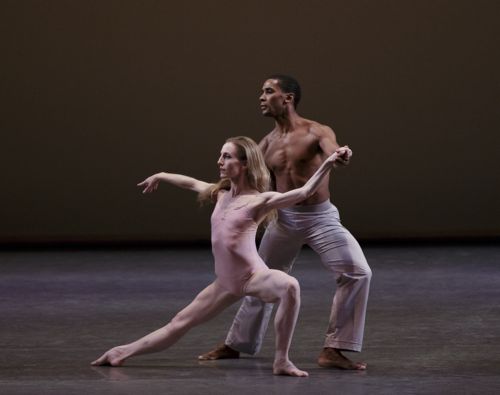
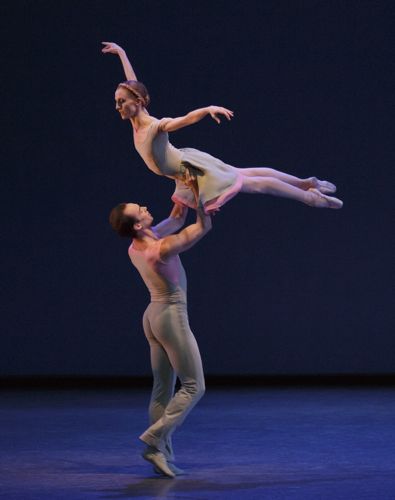
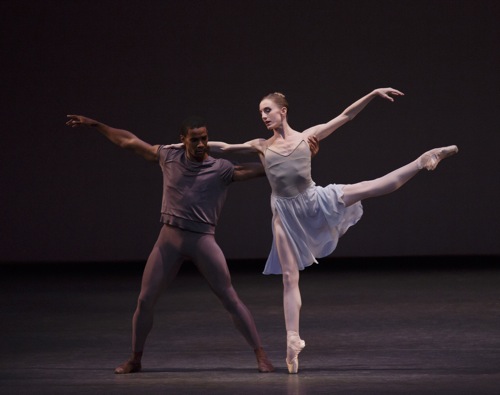
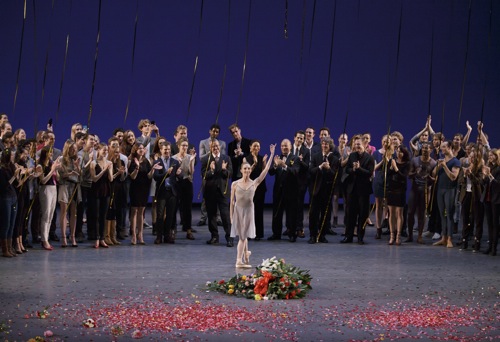
What a lovely, lovely tribute to a ballerina of whom I alas saw little, although she did participate in a fundraising gala for Oregon Ballet Theatre several years ago, dancing a Wheeldon pas de deux, possibly After the Rain. Deborah’s comment about what dancers of different generations tell each other about roles reminds me of the Balanchine Foundation’s Interpreter’s Archive, which films that process. In a filming of The Unanswered Question, Allegra Kent speaks of the influence of La Somnambula, (it was the first ballet she saw as a child and she thought of it in connection with her role in the Unanswered Question in which she is manipulated by four men, who carry her around), a ballet I too find pretty strange. Thanks Deborah for making me think about all this, and once again putting me in the theater with you.